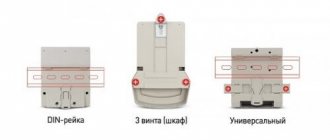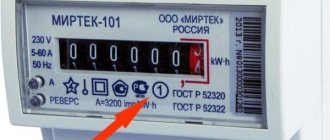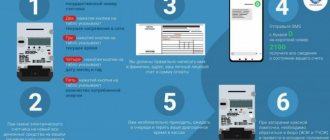Why is it necessary to verify electricity meters?
From January 1, 2022, only “smart” electricity metering systems will be installed. This applies equally to both new houses and old ones in which meters need to be replaced.
The advantage of these devices is that the readings do not need to be transmitted anywhere: the device will do this independently. Housing lawyer Svetlana Zhmurko reminds that there is no need to buy meters: they must be installed by electricity suppliers
Unfortunately, this innovation only applies to electricity meters, but for water and gas supply meters everything remains the same: they must be verified and replaced by accredited organizations.
But verification is necessary in any case. This procedure allows people and employees of management companies to determine that the meter is in normal operating condition and is performing calculations correctly. After all, the most important thing is that payments are calculated correctly.
What are the advantages of smart meters?
The main advantage of smart meters is the complete automation of the data collection process. The devices will independently transmit information about energy consumption to the electricity supply organization. Devices will be able to transmit indicators directly via a home Wi-Fi network, a mobile phone or a SIM card installed in the meter.
One of the main goals of installing smart metering devices is to transfer responsibility for non-payment of bills to the direct violator, and not to divide the amount of the debt of the defaulter among all consumers through the tariff.
Why is electricity sold abroad cheaper than to the population? More details
Timing for verification of electricity meters
As the general director of the KVS-Service Group of Companies Vadim Ushakov , there are two types of verification of electric meters: primary and periodic.
“The first test is carried out on the device after its manufacture, even before its actual operation begins,” the expert notes. - Periodic testing is carried out before the specified end of the specified verification interval - it is indicated in the device passport.
There are also extraordinary inspections. They should be carried out if there are questions about the condition of the device and suspicions that utility bills are being calculated incorrectly. They are also carried out in cases where the document confirming the periodic verification is lost.
Verification nuances
When installing a device for metering consumed utilities, it is necessary that the owner of the facility trusts the IPU, as well as the RSO. Based on this information, the institution will issue invoices for payment.
Thus, all parties to this process must be confident in the correctness of the transmitted evidence. In view of this, when purchasing and installing a meter, experts recommend finding out about the presence of a certificate and accreditation from the manufacturer. Direct installation should be ordered from authorized companies.
The calibration interval of the electric meter has features depending on the installation location - a private household or an apartment in an apartment building.
Watch the video: “Checking electricity meters. How to save money and time."
In a private house
Often in private households, meters that monitor energy consumption are installed on the street. However, this is not a basis for refusing to provide evidence, verify the IPU or agree with the issued receipts.
It is noteworthy that the more complaints the owner sends to the RSO, the more correctly settlement transactions are carried out. But in order to make claims against the company, you must, on your part, comply with the assigned responsibilities, namely: check electricity meters on time.
In addition, the owner of the house must provide RSO employees with the opportunity to:
- verify readings;
- control the integrity of the seal;
- keep honest records within the framework of the law.
Requirements from RSO are also imposed regarding the location where the electric meter will be located. In particular, they relate to compliance with temperature conditions and humidity levels.
In the apartment
The owner of the apartment is not obliged to independently verify electricity meters. Such procedures are carried out by the RSO or the company servicing the apartment complex, according to the established tariff. Directly taking readings and monitoring the performance of the device is free of charge. Analysis of the technical parameters of the IPU costs money - it takes into account the period and current standards.
At the installation site without removal
Important elements on the electric meter.
Verification of the electric meter without removal is carried out by a device for testing and comparing the measured energy due to the frequency of pulse outputs.
The consumer sends an application to a metrological institution or an accredited company to carry out maintenance of the IPU without dismantling. According to the received request, an employee of the organization comes to the address with the appropriate equipment. Experts recommend submitting an application 1.5-2 weeks in advance to avoid missing the verification interval.
Thanks to the mobility of the system, companies can check without removing the device. The equipment used allows you to analyze resource consumption with an error below 0.01%. The devices used are single-phase and multi-phase, low or high power.
Calibration equipment analyzes the operation of individual elements of the IPU. This allows us to identify the correct distribution of errors among parts of the mechanism. The result of the work is influenced by the ratio of the test load on all meter sensors.
In other words, if the indicators are not the same or have inaccuracies, then there is a significant error in the operation of the electrical appliance. In this case, a malfunction is diagnosed and the owner needs to install a new electric meter.
Who verifies electricity meters?
After last year's innovations, verification of meters and their replacement should be carried out by network organizations, energy sales, and so on. It often happens that the verification of such devices is carried out by the suppliers themselves.
“These should be specialized organizations that are accredited by supervisory authorities,” notes Vadim Ushakov . — If you need to dismantle the device, then you should invite an employee of the resource supply organization to record the removal of the seal and record the meter readings.
Who should carry out scheduled verification
Verification of electricity meters without removal is carried out by special enterprises:
- State The metrological institution is authorized to carry out diagnostics of all types of meters.
- Private companies analyze and evaluate the electricity consumption monitoring device subject to certification. A license can be requested before concluding a contract. The document is issued by the Federal Service.
- Organizations serving an apartment building, if there is a certificate of admission to these types of services.
When a citizen applies for diagnostics to a non-state enterprise, it is necessary to check the accreditation certificate for expiration date. Concluding a contract for the provision of services is a mandatory condition. In this case, the text of the document must include information that the company will carry out interval verification of the electricity meter. If you refuse to prescribe such a clause, experts recommend turning to another contractor.
The apartment owner also needs to take into account that in most cases the procedure is carried out with the removal of equipment. In view of this, the owner of the premises is obliged to send a notification to the management company or RSO about the upcoming work, since during this process the seal is destroyed. Such actions are allowed to be carried out only after the official recording of the testimony. Otherwise, the enterprise or management company has the right to review the procedure for calculating fees for the consumed resource during the specified period.
How to find out the verification period for an electricity meter.
How electricity meters are verified
Experts offer the following step-by-step instructions for checking electric meters.
1 step. Apartment owners should contact an accredited company and order an inspection, unless the specialists themselves have planned to carry out this event or have not resolved the issue with your management company.
Step 2. If necessary, the device is dismantled and taken away for examination. In this case, do not forget to invite an employee of the resource supply organization, who will record the act of removing the meter and note its current readings.
Step 3. Specialists carry out all the tests and make a conclusion whether the metering device is suitable or not. The user is given a document confirming the serviceability of the device. If the electric meter is not working well, it will be replaced.
The verification procedure itself includes the following processes: external inspection, checking the electrical insulation strength, checking the errors of the electrical network, etc.
Frequency of verification of electricity meters in Russia by model - table
The frequency of MPI is set at the factory and calculated depending on the type of mechanical device. Most often, devices are provided with an interval of 6-16 years. More precise deadlines are specified in the technical data sheet of the product, endorsed with the manufacturer’s seal. A seal installed on the device body serves as confirmation of the verification of the IPU.
The MPI depends on the characteristics of the equipment used. The regulations regulate the frequency of control for induction mechanisms - no more than 8 years, for electronic devices - a maximum of 16.
The calibration interval of electric meters in the table is presented depending on the brand of equipment:
Table 2.
| Type | Class | Interval period, years | Service period, years |
| SO-I449M1-1 | 2 | 16 | from 30 |
| SO-EU 10 | from 32 | ||
| SO-EE 6705-4 | |||
| SO-EE 6706 | |||
| SO-5 | 32 | ||
| SO-I446-M | from 30 | ||
| SO-505 | 32 | ||
| TsE-2736 | 1 | 30 | |
| ECR2400 | 32 | ||
| CE 102 S7 | 1, 2 | 24 | |
| SOLO | from 30 | ||
| Mercury 201.5 | 1 | 32 | |
| Mercury 200.02 | |||
| Mercury 230 | 10 | ||
| Energy meter CE 102 | |||
| Energy meter CE 301 | |||
| STK-1 (Ukraine) | 6 | ||
| STK-3 (Belarus) | 8 | ||
| NEVA MT 124 | 16 | 30 | |
| Neva 303-1SO |
It is noteworthy that the population pays for such procedures on their own, regardless of the form of ownership - apartment or private household. This is due to the fact that the electric meter does not belong to the general property of the apartment building and is not an element of engineering communications. Accordingly, the service organization is not obliged to monitor the operation of the device free of charge. However, such services are cheap for beneficiaries or residents of municipal premises.
Note: when purchasing an electric meter, experts recommend choosing devices no higher than the second accuracy class. In addition, you need to take into account the period during which the factory verification was carried out: three-phase models - up to 1 year, single-phase - 24 months. During calculations, you need to take into account when the IPU will be installed.
How much does it cost to verify electricity meters?
The cost of checking electric meters depends on the region and many other factors. So, in Moscow and St. Petersburg it is, on average, from one and a half to five thousand rubles.
— You can contact specialized companies, but the easiest way would be to verify the metering device at the resource supply organization that services your home. Such services, as a rule, are provided there,” advises Vadim Ushakov . The cost of verification depends on the prices set by one or another accredited organization. Costs may differ in different localities.
— It all depends on the region. The amount can vary from 1,500 to 3,300 rubles, experts emphasize.
This is useful
Transmitting readings for cold and hot water is a monthly activity for most residents
Types of verifications - table
According to Gosstandart, the electric meter verification period is presented in three types:
Table 1.
| Name of check | Peculiarities |
| Primary | Carried out at the manufacturer's plant. The creation date is entered in the technical. passport. |
| Periodic | Carried out during operation. The scheduled analysis interval depends on the instrument model. |
| Extraordinary | In this case there is no fixed date. To initiate the procedure, the following circumstances must occur:
|
Calibration intervals and replacement periods
Each electric meter model has its own test interval, noted in its technical data sheet. It begins to be calculated from the moment the device is put into operation, and not from the time of purchase or date of manufacture.
Each meter is equipped with a seal indicating the expiration date. For single-phase devices it is 2 years, and for three-phase devices it is 1 year. If during this period of time the device has not begun to be used, then without performing a new verification it cannot be used for accounting. In all apartments and private houses, representatives of the service organization inspect the meters every six months, and in other facilities - every year.
However, sooner or later the time comes when, during the next inspection, it turns out that the electric meter is no longer capable of performing its functions. Many people begin to remember the service life of the meter and quickly decide when to change the electric meter. As a rule, the total period of operation of the device by this time is 16 years. In addition, the reason for replacement may be an unexpected failure of the device, which is detected by the subscriber himself. The device is dismantled and sent to the metrology service for examination for possible further use.
Currently, widespread replacement and installation of new equipment is being carried out, even if the current meter has not been completed by the established inspection date. This measure was initiated by a special government resolution, which requires the installation of metering devices with an accuracy class of at least 2.0.
Service life of devices
In accordance with GOSTs, the service life of electricity metering devices depends on the model. They can be induction or electronic.
In 2022, a new decree was issued stating that it is necessary to replace outdated models of instruments with accuracy of class 2 and lower. This law is necessary in order to eliminate theft and fraud with electricity. With new counters, you won't be able to apply a magnet to slow down the disk. The main models of electric meters and the terms of their use are described below.
Standard Energy Meter
Induction or mechanical models
The operating principle is electromagnetic induction. The current used flows through the roller, which creates a magnetic field. It causes the disk to move and the readings begin to be transmitted to the display. The more powerful the devices connected to the network, the faster the disk will spin.
The service life of induction devices is up to 30 years. Currently, induction meters are no longer produced due to their low accuracy class. It is not recommended to purchase them because you will have to overpay for electricity.
Energy theft using a magnet has also become common in recent years. It was installed on the meter body, due to the magnetic field - the disk slowed down its rotation and distorted the readings.
Mixed type of device
Electronic meters
Such models have a fairly high accuracy class; there are almost no errors in the readings. The main difference from induction is that such models do not have moving disks and coils.
In theory, such a design should increase the service life of the device. But it has not yet been possible to prove this in practice, since these models appeared relatively recently.
Note! Almost all old device models are recommended to be replaced with electronic ones. They are easier to use and operate silently.
You might be interested in this: Installation of a three-phase meter
The service life is 25 years.
Mixed type
Hybrid meters mainly include models whose design contains parts of the two devices described above. Mixed counters do not exist as a separate class. Inside they can be either induction or electronic. For example, a device in which there is a magnetic coil and a screen is located outside is considered mixed.
Calibration interval table
For hybrid electrical appliances, the service life is set depending on the design - 25-30 years. These models are much cheaper than induction and electronic ones.
Who pays and the cost of checking the electricity meter
The owner of the property independently bears the burden of expenses for servicing the electric meter.
This applies to the following activities:
- dismantling;
- transportation;
- diagnostics;
- installation;
- installation of a seal.
The cost of checking the electric meter will depend on its type and model.
The table shows the estimated cost of the service:
Table 3.
| Service name | Cost, rubles |
| Induction single-phase devices | 600-800 |
| Verification of a similar device, but electronic | 700-900 |
| Three-phase energy metering equipment | |
| Mechanical | 800-1000 |
| Electronic | 850-950 |
| Current prices should be obtained from organizations that verify electricity meters. | |
It is noteworthy that private companies offer additional services so that the consumer does not overstay the verification interval.
For example:
- diagnostics within 5 days leads to an average price increase of 20%;
- if similar work needs to be completed in 3 working days, then by 50%;
- high urgency of the event leads to the establishment of a premium of 100%.
Free verification
Free verification is available to citizens who have entered into a social tenancy agreement or to users of municipal housing.
What documents are issued after verification - types of marks in the act
Calibration interval of the Mercury meter.
If the verification interval of the electric meter expires, then it is necessary to submit an application to the state metrological center or a private company. In the document about the certified device, the employee of the institution is obliged to put notes not only about the fact of diagnostics, but also to reflect the dismantling and installation of the IPU.
According to regulatory provisions, legal removal of the device is carried out by RSO employees.
An employee of the institution is authorized to carry out the following activities:
- Comparative analysis of current electric meter readings.
- Preparation of documents for dismantling IPU.
- Initiate the transfer of settlement transactions from the amount of consumed resources according to average standards.
Removal and installation of equipment is also carried out by employees of an energy-saving institution. After installation of the resource metering device, sealing is carried out. Such operations are permitted by accredited persons. Violation of the control label is subject to administrative penalties.
After replacing the IPU, if necessary, an act is generated. The document is endorsed by two parties - the owner of the premises and the contractor.
The paper must be drawn up reflecting the following information:
- address of the property where the work was carried out;
- technical parameters of the removed and installed device;
- date of procedure;
- the day of verification of old and new equipment;
- indications;
- the number of unaccounted resources at the time of the absence of the IPU;
- reasons for replacement;
- data of the company that carried out the maintenance of the electric meter, including details.
In case of installation of a new individual metering device, it is necessary to draw up an act in two copies. One copy remains with the apartment owner, the second is transferred to the RSO. If only verification was carried out, then the date is stamped on the seal and is additionally displayed in the technical passport. The next verification interval will be counted from this day.
According to current laws, an employee of the organization must also reflect in the documents the identified shortcomings and errors in the transmitted readings. Correct operation of the equipment depends on the type of device being used and ranges from 6 to 16 years.
What is the difference between the expiration date and the inter-verification period and the warranty?
During the period of checking and sealing of any electricity metering device, the countdown of its service life begins. This is the time that is written in the meter’s passport under the service life column.
In the documents, next to the device startup date, the time and date of the next test that will need to be performed is indicated. This time is called the inter-verification interval (ICI).
Sometimes, during normal operation, visually invisible defects may appear in the device. This is why an inter-inspection interval is needed in order to eliminate device malfunctions in a timely manner.
Instrument testing process
The warranty is the period that is given for free repair of the meter in the event of a malfunction. On average, the warranty period is 3-5 years.
Calibration intervals may be different, it all depends on the type of meter. For single-phase - 3 years. For three-phase - a year. Electronic models can be tested once every 16 years.
Different types of diagnostics can be prescribed for different times. For example, if the device itself needs to be checked once every 16 years, then error diagnosis and battery testing are performed once every 6 years. Diagnostics of the security of the meter connection can be assigned to special organizations at any time (accompanied by a warning letter one week in advance).
When checking the connection safety, remove the cover from the device, tighten the nuts, and remove dust from the wires. The beginning of the verification interval is the day the meter is sealed and put into operation.
Replacing the old meter
When the MPI expires, the metrological organization can provide a certificate stating that the meter is functioning normally and can be used.











